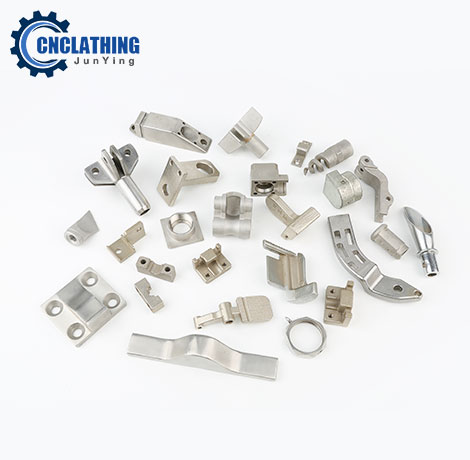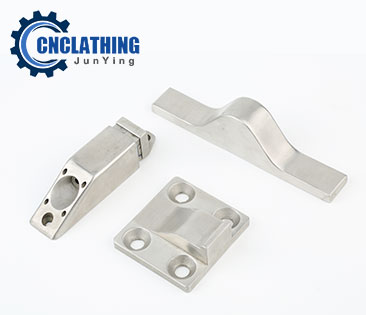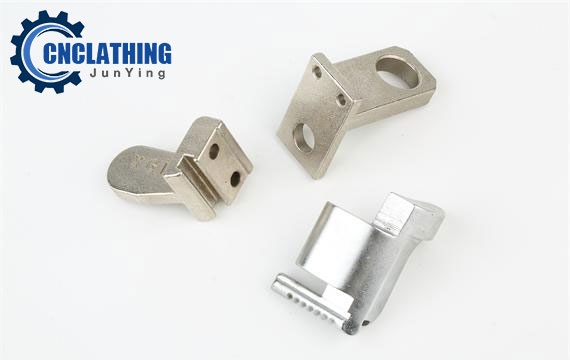Investment Casting Services & Parts Supplier – China Lost Wax Investment Castings Manufacturer
If you focus on the shape complexity and surface finish of the parts, investment castings are where you can go. In order to meet the mass production requirements of some customers and reduce the cost, we work with our suppliers to assist your project. Junying investment casting services can reduce the processing time and cost of CNC machining parts, as we can manufacture a large number of prototypes in batch quickly and modify the appearance with CNC techniques to deliver the final desired parts. Whether you want to look for an investment casting manufacturer casting stainless steel, carbon steel, aluminum, or brass, professional technicians will perform investing casting process with a wide variety of metals, and be able to offer complex detail, smooth surface finish, and high definition in an economic way for clients. Our investment casting parts are used across broad fields, such as energy, automotive, gas, and oil, food, etc. ISO 9001 certification and multiple-stage quality inspection implementation will ensure the quality and performance of the lost wax casting products to be delivered.
Why Choose Junying Investment Casting?
- Close design review on tolerances, undercuts, and more details for higher production yields and lower cost.
- If CNC services are required, advanced equipment and extensive experiences will work on less budget and time.
- From concept to prototype to end-use products, our experts will help you with an advantage of speed and reliability.
- Metal surface finishing, quality assurance testing, and more services can be provided to make the castings fit specifications.
- Full-service investment casting factory and high automation reduces the time of each step, ensure the shortest lead time.
Materials Used in Lost Wax Casting – Types of Investment Castings
- Stainless Steel Investment Castings: 410, 416, 420, 303, 304, 304L, 316, 316L, 17-4PH, etc.
- Alloy Steel Investment Castings: 1045, 1050, 4130, 4140, etc.
- Copper Alloy Investment Castings: CDA 872, CDA 875, CDA 903, etc.
- Aluminum Investment Castings: 356
What is Investment Casting?
Investment casting, also known as lost-wax casting, is one of the oldest known metal-forming techniques. The reason why investment casting goes its name is that the process invests the wax pattern with refractory materials to form the mold, and the molten material is cast into the die. The shape of the cavity inside the mold is an exact duplicate of that of the desired product. Common materials used in investment casting including stainless steel, carbon steel, aluminum, and brass. Investment casting has been used in the last 5000 years, in the earliest time, beeswax was used to form the patterns, later, more advanced waxes are applied to make the wax mold. Most of the wax used in lost wax casting can be recycled. Investment casting is a popular manufacturing way because it is capable of producing parts with high accuracy, repeatability, and integrity in a variety of metals and alloys.
How Does Investment Casting Work? – Investment Casting Process
Investment casting (lost wax casting) is the process of using wax to make the mold of the parts to be cast, and then the wax mold is coated with mud, which is called clay mold. After the clay mould is dried, heat and melt the inner wax mould. Take out the clay mold after melting the wax mold and bake it into a ceramic mold. Generally, the gate system is left when making the mud mold, then the molten metal can be poured into the mold. Cool it until the part solidifies, the required parts are made.
Steps of Investment Casting Process
- Inject wax into a permanent die form wax pattern with the same details of the cast part.
- Assembly multiple wax components to form the gate and runner system.
- Immerse the entire wax assembly in refractory material like ceramic slurry, make it fully covered with the stucco, and forms a ceramic shell, which is built around a tree assembly by repeatedly dipping a pattern into a slurry.
- Heat the entire assembly to melt away the wax.
- When the residual wax pattern and gate material have been removed, the ceramic mold remains with a cavity in the shape of the part.
- Preheat the metal and pour the molten metal into the mold.
- Once the castings cooled, remove the part from the mold.
- Post-processing and machining to achieve required specifications.
- Dimensional and quality inspections and other testings before shipment.
Advantages of Investment Casting
- Investment casting can provide complex configurations of various alloys, such as intricate passages and contours with consistent close tolerances. Some of them can hardly be done with machine tools.
- Even though most investing castings are in relatively small sizes, some investment casting companies with advanced machines and special expertise have the ability to make cast parts weigh more than 1000 pounds.
- Multiple components can be combined into a single investment casting at one time through lost wax casting, which makes it a good alternative to welding. This also gives higher dimensional accuracy and lower complexity.
- The high integrity of investment castings enables it to serve various applications for a long time, including chemical, medical, defense, automotive, and more.
- The ceramic shell is created using refractory coating made of high temperature resistant special binder and refractory material, which is coated on the wax mold. The inside surface of the cavity which is in direct contact with the molten metal is smooth. Therefore, the surface finish of investment castings is higher than that of ordinary castings.
- Good dimensional accuracy and surface finish reduces the needs of post-machining work, only leave a little machining allowance in the parts with higher requirements, investment casting can save a lot of cost of equipment and shorten the whole processing time.

Applications of Investment Casting
✅ Aerospace
Precise and intricate investment casting parts are necessary for
aircraft and jet engines. For example, turbine blades made from Inconel
718 often include intricate internal cooling passages to maintain engine
efficiency under extreme temperatures. Titanium brackets are also cast
to reduce overall weight while keeping strength. Additionally, aluminum
lost wax castings are used in pressure vessels and other structural
parts to meet the requirements of lightness and durability.
✅ Automotive
Stainless steel turbocharger housings made from investment casting suppliers are a common example, helping engines deliver more power while reducing fuel consumption and emissions. Transmission gears made through this process contribute to smoother and more efficient gear shifting to achieve the best performance. Investment casting also supports the growing electric vehicle market by producing battery cases and electronic components with exact dimensions and excellent material properties.
✅ Medical
The medical field benefits from investment casting by obtaining parts
that demand biocompatibility and accuracy. Cobalt-chrome scalpels are
produced with smooth, sterilizable edges, ensuring safety during
surgical procedures. Titanium hip implants are another common
application, where precise casting guarantees a perfect fit and
long-lasting durability inside the body. Beyond implants, surgical tools
and dental instruments also rely on this method.
✅ Industrial Machinery
In industrial machinery, investment casting is used to manufacture
components that must resist wear and corrosion. Stainless steel pump
impellers improve the efficiency of fluid movement within machines.
Valve bodies, often containing complex internal passages, are cast to
manage flow effectively while resisting deterioration over time.
✅ Defense
The defense sector uses investment casting to produce firearms and
weapon parts made from strong alloys. Components like bomb racks,
missile launchers, and communication equipment housings require high
durability to perform consistently during military operations. Lost
wax casting services allow these parts to be made with the necessary
detail and strength to meet defense standards.
✅ Food Processing
Investment casting supports the dairy and food industries by
providing parts that meet hygiene and durability standards.
Components for commercial dishwashers, meat slicers, ice machines,
and candy-making equipment are created with smooth surfaces and
complex shapes to ensure easy cleaning and long-lasting use. These
castings help maintain efficient and sanitary food processing
operations.
✅ Marine
Marine applications often involve exposure to harsh, corrosive
environments. Investment casting provides parts like pumps, deck
hardware, bearing housings, and electronic enclosures that stand
up to these conditions. Engine components, seal housings, and
rings also benefit from the precise casting process, which
ensures durability and reliable performance in marine settings.
✅ Military
Energy or power generation industries, including petroleum,
natural gas, wind, and nuclear, use investment casting to
create parts such as clamps, valves, and meter housings.
Valves like butterfly valves and backflow preventers, made
through investment casting, play important roles in
controlling fluid flow safely and efficiently.
✅ Save Time and Cost
Online CNC programming services eliminate the limitations of
physical distance and help alleviate the shortage of skilled
labor. Users can access qualified experts globally without
paying expensive in-house or on-site service fees.
Sand Casting vs Investment Casting: What Are the Differences and Which One to Choose
1. Cost
Investment casting services generally involve higher costs than sand casting because this process needs extensive preparation, and the materials, like wax and ceramic slurry, are also more expensive than the sand and binder used in sand casting.
2. Part Weight and Size
Investment casting is specialized for producing smaller, more intricate parts usually weighing up to about 150 pounds, such as thin walls. But there are bigger limitations on the part size and weight. Sand casting is capable of producing very large castings weighing up to 6,000 pounds or more.
3. Surface Finish Quality
Investment casting parts usually come with a smooth, high-quality surface finish that requires minimal post-casting machining. The ceramic shell mold replicates the wax pattern’s fine details, yielding parts with excellent surface polish. However, sand mold often leaves a grainy texture and parting lines from mold splitting, so the final parts will have a rougher surface finish, which requires additional machining or finishing.
4. Design Complexity and Flexibility
Investment casting offers superior design flexibility, enabling the creation of highly intricate and delicate shapes, including thin walls and internal cavities. The use of a wax pattern and ceramic shell allows for near-unlimited geometric complexity, including undercuts and hollow sections, without extensive tooling changes. Sand casting is more restrictive in design because the sand mold must be split to remove the pattern, requiring draft angles and simpler shapes to avoid mold damage. Complex internal cavities need specially formed cores, which add time and cost, and design changes are easier to implement in sand casting due to simpler pattern modification.
5. Dimensional Tolerance and Accuracy
Lost wax casting provides much tighter dimensional tolerances compared to sand casting. Typical tolerance levels in investment casting range from CT 4 to CT 6. The tolerance of sand castings is generally around CT 10 to CT 13, which means parts need thicker walls (minimum 3 to 5 mm) and may require additional machining to achieve exact measurements.
6. Cycle Time and Production Volume
Sand casting has a relatively short mold-making cycle, which allows for faster turnaround times, especially suitable for prototyping and small to medium production runs. Its molds are single-use but quick to produce, which benefits projects needing rapid changeovers. Investment casting has a longer cycle time due to multiple stages, and is well-suited for mass production of consistent, high-quality parts.
7. Reuse and Sustainability of Materials
In investment casting, the wax used to create the pattern is melted out and can be reused multiple times. The ceramic shells, however, are destroyed to retrieve the casting. Sand casting molds are single-use, but the sand itself can be recycled and reused after the casting process, reducing waste and operational costs in large-scale foundries.
Choose Investment Casting When:
- Your part requires high precision and tight dimensional tolerances.
- The design includes thin walls, complex geometries, or internal cavities.
- You need a superior surface finish with minimal post-processing.
- You are producing small to medium-sized parts, typically under 150 pounds.
- Prototyping or small production runs are required with quick design iteration.
- Your application demands specialty metals or alloys with fine detail.
Choose Sand Casting When:
- Your project involves large or heavy parts that can weigh from a few pounds up to several thousand pounds.
- You need a cost-effective method with lower tooling and material costs.
- The design is relatively simple or moderate in complexity.
- You require fast turnaround times and the flexibility to change designs quickly.
- You are working on high-volume production with less emphasis on surface finish.





